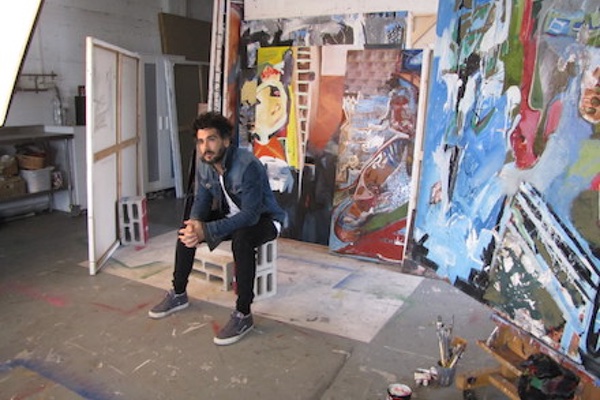From Margin to Center
Interview by Emily Jaeger, Features Editor

Gil Desiano Bitton is a painter living in Tel Aviv. He received his MFA from The Faculty of Arts – Hamidrasha at Beit Berl College. Bitton’s work was featured in multiple solo exhibitions in Israel, including The Artists House, Tel Aviv and Sissman Gallery, Tel Aviv. He has also participated in international group exhibitions including VOLTA12 Art Fair, Basel, Switzerland and the Upstream Gallery’s “PaperWorks” in New York. Bitton’s paintings are in private collections in Israel and abroad.
Jaeger: Your paintings appearing in this month’s issue are a selection originally inspired by an image you have of your grandmother’s hands while she would sit in her armchair. Why did you choose this memory as a subject of artistic inquiry?
Bitton: The image of my grandmother’s folded hands is one of a series of images and memories from my childhood neighborhood that I am investigating in my recent work. The image of her hands, which to anyone else might seem insignificant or meaningless, for me, holds great weight—portraying strength and restrained energy. I am happy to place this image at the center of my work.

Jaeger: Many of your paintings in this issue are mixed-medium on plywood. Why did you decide to paint on plywood?
Bitton: Originally, I painted on plywood because it was available at the time. Plywood is a cheap material, dull, lacking in any inherent meaning. Since, as an artist, I often focus on what is marginal or insignificant, I ended up deciding to continue painting on plywood. Without even realizing it, I had taken an insignificant material, asserted a great deal of meaning upon it, and positioned it at the center of my art.

Jaeger: Your paintings are rife with architectural imagery—wallpaper designs, figures reminiscent of urban buildings. Could you talk about the role of architecture in your work?
Bitton: The recurring images of buildings in my paintings are based on the row houses that characterize poor and distressed neighborhoods in Israel. They were originally built as a quick solution to the large waves of Jewish immigration to Israel in the 1950s from North Africa. These buildings usually fade into the scenery. In my work they are the focal point.

Jaeger: In your artist statement you write, “my work investigates the relation between image and abstraction.” How did this investigation shape your creative process in the painting Nowhere Man?
Bitton: In my earlier work, I was often drawn to a conflict between the imagistic and the abstract, with both vying for center stage. In the end, the imagistic would lose and be cast into the margins. In Nowhere Man, an unresolved struggle takes place between multiple important images. The painting suggests that perhaps all the images are both marginal and central. It is up to the viewer to decide where to focus.
Jaeger: In both Surrounded and Scorched Earth, you include writing as part of the composition of each painting. How did you come to make this artistic decision?
Bitton: My decision to incorporate text into these works stemmed from the desire to illustrate the hybridization of two worlds in Israel: Mizrachim (Jews from North Africa) and Ashkenazim (Jews from Eastern Europe), as well as insert some hidden humor into the intercultural struggles between these two groups. In Scorched Earth, I tried to combine the word “Morocco” with the “Rococo” period of art. The result was “Marococo.”

Jaeger: Vibrant blocks of color are often contrasted against layered and intricate details in Surrounded. Could you talk about this stylistic choice?
Bitton: In Surrounded, I made an effort to establish the centrality of the neighborhood with vibrant colors. But in reality, the neighborhood was full of dull colors, crumbling walls, and deafening silence.

Jaeger: Many of your paintings serve as a platform for the questioning of divergent Israeli social and political issues today. How did these issues come into play in Untitled?
Bitton: The majority of my paintings have titles which are connected in one way or another to societal or political issues in Israel. However, some issues are seen as extremely marginal or meaningless in Israeli society. They are best described (ironically) with the expression Untitled: something too insignificant to be named. In this painting, I wanted to create tension between loaded elements in the work—intensity of the color, images, and composition—with the name of the piece.

Jaeger: How does this project fit into your body of work? What do you think is the impact of these paintings on your evolution as an artist?
Bitton: I began this project after returning to the impoverished Israeli neighborhood where I grew up. The paintings are based on the process of photographing and documenting what I found there. This series reconnected me with my desire to bring the marginal to the center. If I am able to raise awareness about the issues raised in my paintings or just cause the viewer to pause for a moment in front of my work, I will have already succeeded. Because, in reality, most would pass the neighborhood without giving it a second glance.

Copyright 2016 Woven Tale Press LLC. All Rights Reserved.

